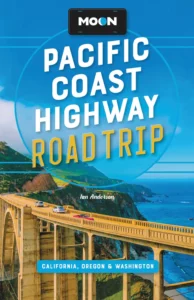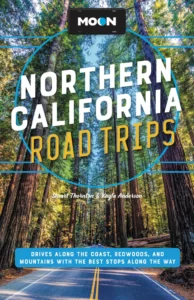Russian River to Bodega Bay
Jenner, Guerneville, & the Russian River
South of Fort Ross, Hwy-1 climbs high above the rugged coastline, offering breathtaking vistas of the Pacific Ocean hundreds of feet below. Twelve miles south of Fort Ross, Hwy-1 reaches the low-key resort community of Jenner (pop. 139), which stretches along the broad mouth of the Russian River. Harbor seals and sea lions sun themselves on the beach at Goat Rock, houses climb the steep hillsides, and there’s a gas station, a post office, and the excellent River’s End (11048 Hwy-1, 707/865-2484, daily in summer, otherwise Thurs.-Tues.), which has a range of great food—everything from burgers to seafood—and ocean-view tables inside and outside, depending on the weather.
From Jenner, Hwy-116 runs east along the river, passing through forests, vineyards, and popular summertime resort towns, the largest of which is Guerneville, 13 miles away, with a number of worthwhile cafés and a largely gay and lesbian summer population. A more traditional place, with a broad but gravelly beach, boat rentals, cabins, and riverfront camping, is Johnson’s Beach & Resort (16215 and 16217 1st St., 707/869-2022). After 35-odd miles, Hwy-116 eventually links up with the US-101 freeway to and from San Francisco, providing a faster alternative to coastal Hwy-1.
Sonoma Coast State Park
South of Jenner and the Russian River, Hwy-1 hugs the coast along 10 miles of rocky coves and sandy beaches, collectively protected as Sonoma Coast State Park (707/875-3483). Starting with Goat Rock at the southern lip of the Russian River mouth, a bluff-top trail leads south past intriguingly named and usually unpopulated pocket strands like Blind Beach, Schoolhouse Beach, Shell Beach, Wright’s Beach (site of the park’s main beachfront campground), and Salmon Creek Beach. Take care when hiking along the Sonoma Coast: Many people have been drowned by “sleeper” waves, which rise unannounced and sweep people off the rocky shore.
At the southernmost end, Sonoma Coast State Park broadens to include the wildflower-covered granite promontory of Bodega Head, which juts into the Pacific and provides a great vantage point for watching the gray whale migrations in winter.
Bodega Bay
Protected by the massive bulk of Bodega Head, the fishing harbor of Bodega Bay has grown into an upscale vacation destination, with Sea Ranch-style vacation homes lining the fairways of golf resorts and deluxe hotels overlooking the still-busy commercial wharves.
On the waterfront, the Lucas Wharf Restaurant & Bar (595 Hwy-1, 707/875-3522) dishes up fish ’n’ chips and clam chowder. Next door, the Fishetarian Fish Market (599 S. Hwy-1, 707/875-9092) has fantastic fresh rock cod fish ’n’ chips, tasty fries, and a large fresh-fish market. If you’ve had your fill of fish, continue south to the rustic U.S. Post Office and mini-mall west of the highway, where you can enjoy milk shakes and hot dogs at The Dog House (707/875-2441).
South of Bodega Bay, Hwy-1 cuts inland around the marshy coastal estuaries, passing by the photogenic small town of Bodega, whose Victorian-era hilltop church was used by Alfred Hitchcock for many of the scariest scenes in his 1963 movie The Birds. In 1976, international artists Christo and Jeanne-Claude used Bodega as a key tableau in their installation Running Fence, which draped an 18-foot-high, nearly 25-mile-long fabric curtain across the rolling ranchlands of Sonoma County, from the coast to the inland valleys.
There’s not much sign of Hollywood directors or conceptual art in these parts today, but Bodega is a nice place to wander and explore, and the down-home Casino Bar & Grill (17000 Bodega Hwy., 707/876-3185) at the center of “town” is more welcoming than it might look, with a well-worn pool table and excellent locally sourced food most nights.
Northern California Travel Map

















